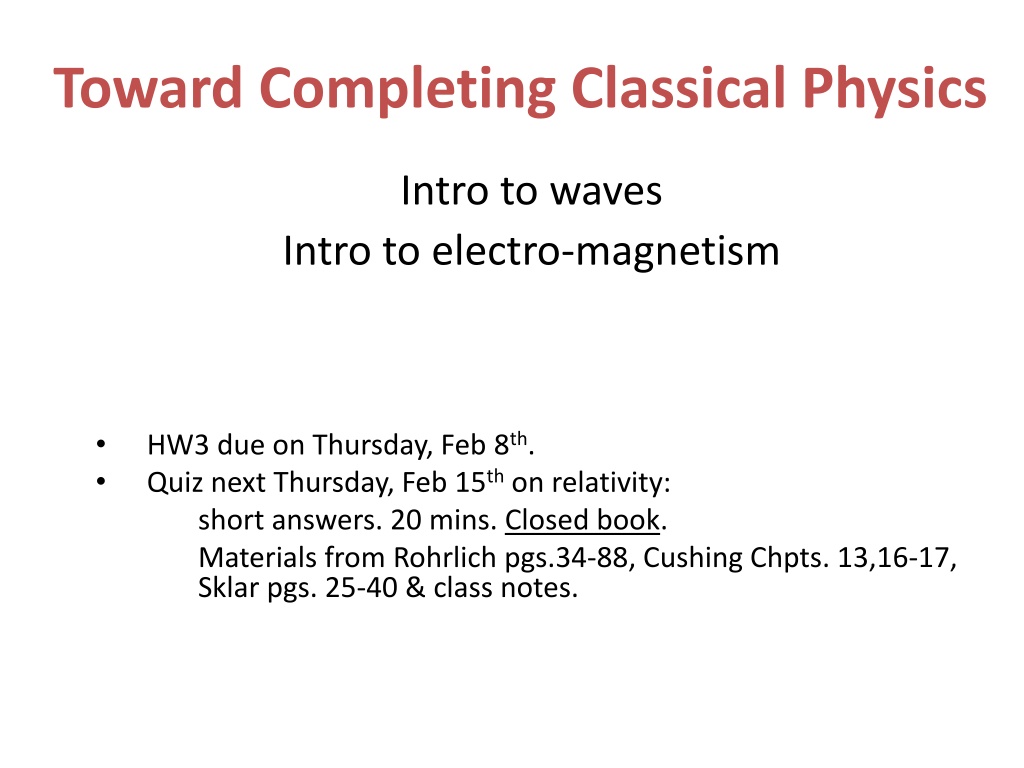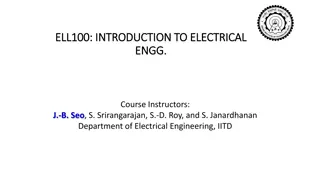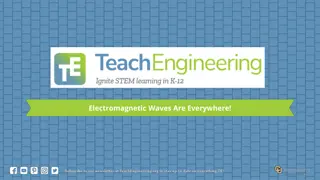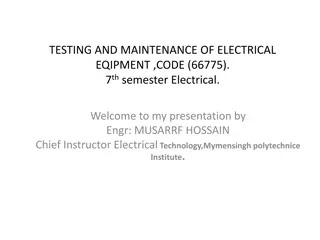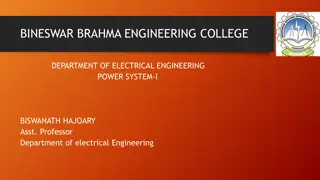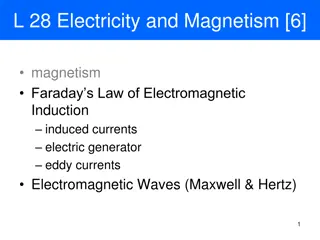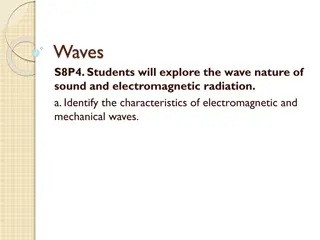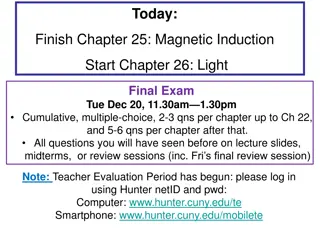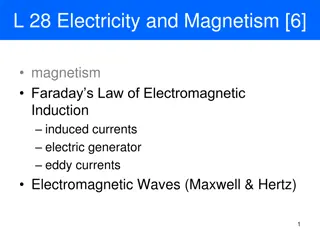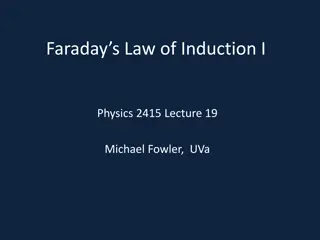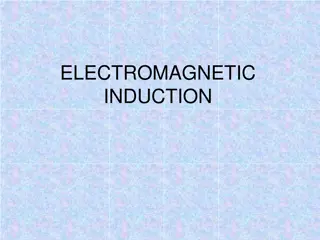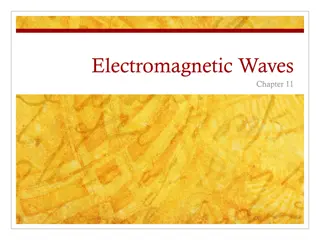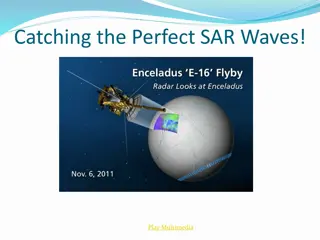Electromagnetic Induction for Electrical Energy Generation
Electromagnetic induction, first demonstrated by Michael Faraday, is crucial for generating most of the electrical energy used today. It involves producing electricity through magnetism, with factors like velocity, magnetic field strength, and wire length influencing the induced current. Lenz's law states that the induced current opposes the change in the applied magnetic field, in line with the conservation of energy principle. Explore the workings of electromagnetic induction and how it enables the production of electricity efficiently.
Download Presentation

Please find below an Image/Link to download the presentation.
The content on the website is provided AS IS for your information and personal use only. It may not be sold, licensed, or shared on other websites without obtaining consent from the author.If you encounter any issues during the download, it is possible that the publisher has removed the file from their server.
You are allowed to download the files provided on this website for personal or commercial use, subject to the condition that they are used lawfully. All files are the property of their respective owners.
The content on the website is provided AS IS for your information and personal use only. It may not be sold, licensed, or shared on other websites without obtaining consent from the author.
E N D
Presentation Transcript
Toward Completing Classical Physics Intro to waves Intro to electro-magnetism HW3 due on Thursday, Feb 8th. Quiz next Thursday, Feb 15thon relativity: short answers. 20 mins. Closed book. Materials from Rohrlich pgs.34-88, Cushing Chpts. 13,16-17, Sklar pgs. 25-40 & class notes.
Energy: Thermodynamics Joule: there is a huge amount of stored thermal energy. Raising the temperature of water by 1 C takes as much energy as getting it going 90 m/s (~350 mph). Extending energy conservation to conversion between thermal and mechanical forms is the 1st law of thermodynamics. Conservation of energy is not the whole story. While it is possible to convert all mechanical energy into heat (e.g., by friction), the reverse is not possible. Overall, mechanical energy is inevitably lost to heat. Carnot first realized this ~1820. One consequence is that there cannot be a perpetual motion machine. Carnot s analysis of irreversibility was done using the caloric theory. We shall preserve his connection between water running downhill, and heat flowing to colder regions, but put both in a broader context, when we return to this topic. An implication of thermodynamics: Heat death of the universe (Kelvin, 1852) The second law implies that the universe will eventually run down. The stars will burn out, etc. Doesn t fit with the simple notion of an eternal universe. We ll discuss the origin and fate of the universe later.
Newtonian cosmology The universe must be infinite for several reasons: A finite one has a center and edge (i.e., absolute position). Hard to reconcile Euclidean geometry with a finite universe. Where is the edge? However, an infinite universe has at least two problems: Olber s paradox: In an infinite, homogeneous universe, whichever direction one looks there will eventually be a star, so the night sky should be bright. You can imagine ways around this problem: e.g., dust, Actually, dust doesn t work in an infinitely old universe. The dust would just heat up and glow like a star. Can the universe be infinitely old? What about the finite stellar lifetime, from conservation of energy? Mathematical problem: There are no solutions to the equations that describe a gas-like collection of a bunch of things whizzing around, with gravitational interactions that don t collapse. This issue will come up again in general relativity.
Waves Wave phenomena are important for the development of special relativity and for understanding quantum mechanics, so here is a brief classical description of waves. Waves in a string, on water, or in air (sound) all share several features. These waves are not independent constituents of the world, just a mode of behavior of matter obeying force laws. There is a medium which is normally at rest, or at least is undisturbed. The wave is a disturbance in the medium. Pluck the string, or create a high pressure region in the air. A wave moves through the medium with a velocity with respect to the medium. An ordinary wave is spread out over a range of positions and also is travelling with a range of velocities Waves can come in various packets, with a range from v pretty well-defined positions to pretty well-defined wavelengths. v wavelengt h =
Wave properties Intensity: The amount of energy carried by a wave is proportional to the square of the amplitude (height) of the wave. Both negative or positive amplitude have positive energy. Interference: The intensity of adding two waves depends on whether they are in phase or out of phase or in-between: (a+b)2 = a2+b2+2ab a2+b2, so Ia+b Ia+Ib wave crests Two waves obliquely incident on a screen Maximum intensity where crests (or troughs) coincide At a given point, the intensity of two waves together can be less than either one separately. Energy conservation still works because at other points the intensity is greater than the sum of the separate intensities.
Refraction and reflection Waves are refracted and partially reflected at a boundary: I n http://www.linsgroup.com/Physics/Physic_Pic1.jpg Ref. Trans. www.linsgroup.com/Physics/Newton_Ring
Wave properties The wave moves at some speed with respect to the medium. So one can learn about the motion of the medium by observing only the wave. Doppler effect. If the source of a wave is moving towards the observer, or the observer toward the source, the crests become squeezed together. More of them pass the observer per second, and the frequency is higher. This is the cause of the familiar train whistle effect. The classical formula for the Doppler effect depends on both the velocity of the observer wrt the medium and the velocity of the source wrt the medium, NOT just on the relative velocity of the observer and source. E.g. if the observer is moving away from the source at the wave-speed, the observed frequency will be ZERO regardless of the details of the source motion. E.g. If the observer moves away at 1/2 the wave-speed, and so does the source, the observed frequency will be 1/3 of the source frequency. The relative source-observer speed is the same as above, but 1/3 is not the same as zero.
Electro-Magnetism The fundamental force involved in most daily experiences is electro- magnetism. We won't follow the historical development (Franklin, Coulomb, Ampere, Faraday, Maxwell ) but will just give the result, which bears a strong resemblance to gravity. Electricity: There is a property of each object called its charge, q. The electric force between two charged objects is given by: which should remind you of the law for gravity: q q F = 1 r 2 2 F =GMm r2 There's another force, magnetism, between electrically charged objects with some velocity: Magnetism: What is different about these forces?
Galileos Relativity Gone? This force law gives a different result if you add some velocity to both v1 and v2. The magnetic force depends on the absolute velocities, not on relative velocities. Galilean relativity is broken by the magnetic force law! Did Galilean relativity apply only to some mechanical laws, but not really to the laws of physics as a whole? Is there some other relativity that works? Isn't that possibility just what Newton's philosophical ideas about absolute space had suggested? If we assume some aether which is the medium in which E-M waves propagate, might it not also provide the reference frame in which Maxwell's equations are true? (i.e., only one at rest w.r.t. the aether) AND provide the medium for gravity? Would we then have all spatial properties be purely relational, but against a background of simple aether properties?
Action at a Distance and Fields One of the most worrisome features of Newton s theory of gravity was that it required objects to affect each other across empty space. Newton thought that there must be some mediator, but he did not know what it was. With the study of electricity and magnetism it became useful to distinguish the source of an effect from the object of its effection . It was noticed that for all three forces (gravity, electricity, and magnetism), the effect of an object on any other object can be written as the product of two terms, one depending only on the first object (called the source) and the other only on the second object. r GMm F = = 2 g m a g Gravity: Electricity: Magnetism: r q q r 1 2 = = F E q ( a ) E q m / 2 2 2 r q q v v r 1 2 2 1 = F q v B 2 2 2 r g, E, and B are called the gravitational, electrical, and magnetic fields, respectively. The field is a useful mathematical device, but are these fields real ? How to tell? In order to be real, they ought to have some independent manifestation, besides just giving a simple way to calculate forces between objects.
Electromagnetism and the Aether Electric and magnetic fields were discovered in the 19th century to have two properties which gave credence to their reality. Faraday discovered that if the magnetic field B varies with time, this gives rise to an electric field E. Relation of E and B is not just a re-description of forces between charges. James Maxwell discovered (1864) that changes in E give rise to B as well. That implies that E and B can exist in the absence of any electrical charges (i.e., no sources). Maxwell unified the description of electricity and magnetism and claimed that light is a wave composed of oscillating E and B fields. He predicted the existence of other electromagnetic waves, which were observed by Hertz. Three previously distinct phenomena have been subsumed by a single theory.
Two problems for Maxwell's E&M theory 1. When an EM wave propagates through the vacuum, what is the medium? What is oscillating? The equations that describe electrodynamics violate Galilean invariance. This violation should show up in the wave motion. Is the speed of light uniform only constant with respect to the medium? 2. The medium was dubbed the luminiferous aether, the stuff of which E-M fields are the disturbances.
Classical Physics We have now completed an introduction to the classical synthesis of physics. The common view was that in all important questions, physics was complete. Lord Kelvin, in 1900, made a famous speech declaring that physics was basically done, except for two little "dark clouds on the horizon": 1. Black-body radiation 2. The Michelson-Morley experiment. Before we encounter stormy weather, let's try to sum up classical physics and its relation to traditional philosophical questions.
Physics (as of 1900) Nature consists of particles and fields, embedded in time and space. Elementary ingredients of the classical description: Position and time are both undefined quantities. One cannot explain them to someone who does not already have a mental construct. Try to imagine a universe with two time dimensions. Mass is another undefined quantity. Its mathematical behavior is defined by Newton s second law together with specific force laws, and some rule for measuring accelerations. We still need some implicit understandings to connect all these constructs to actual experiences. The influence of the particles and fields on each other is described by definite deterministic equations. Not all the particles and fields are known. There are other empirical forces, but only G and E&M look fundamental. None of the detailed properties of chemistry, materials, etc., are accounted for. They might require some new fields on a small scale. There are some unifying conservation laws related to symmetry: Momentum, angular momentum, energy, mass, electrical charge, atoms. Symmetries Time translation, space translation, rotation, mirror-image (parity), Time reversal (but, oddly, only on a microscopic level) Galilean relativity (but not for electromagnetism!)
